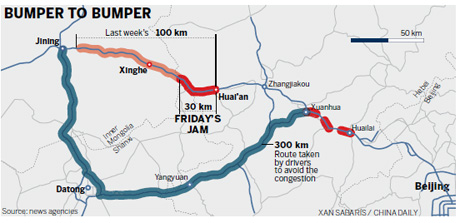Monster jam chokes up N. China expressway
Many local merchants capitalized on the stranded drivers' predicament by offering food and drink at inflated prices. Local media reported that some even offered to show drivers a way around the traffic jam on the back roads -- for a 50-yuan (US$7) fee.
A China Post mail truck traveling from Hohhot to Beijing was among vehicles paralyzed by the jam.
Forty-four-year-old Jia Wensheng told China Daily he was worried because people were waiting for letters and packages.
Ironically, a traffic police car was also among vehicles caught in the tailback. It had been dispatched to help disperse traffic.
"There was a rear-end collision on the highway, but we cannot get over there," said a traffic policeman, who refused to be named.
Experts blamed the recent jams on fast urbanization and overstretched infrastructure.
Zhao Jie, deputy director of the Urban Transport Institute under the China Academy of Urban Planning and Design, told China Daily the nation's highways have to cope with fast and heavy traffic and increasing population demands.
"With fast urbanization, more urbanites are living on the outskirts at night while working in downtown areas during the day," Zhao said.
"Take Beijing for example, the city now has more than 4 million vehicles and traffic jams are becoming common."
He said the coming five to 10 years will be crucial in developing the capital's public transportation system. He said the authorities will need to continue the expansion of the subway system, create inter-city light rail routes and add buses to relieve the heavy traffic.

 0
0 







Go to Forum >>0 Comments